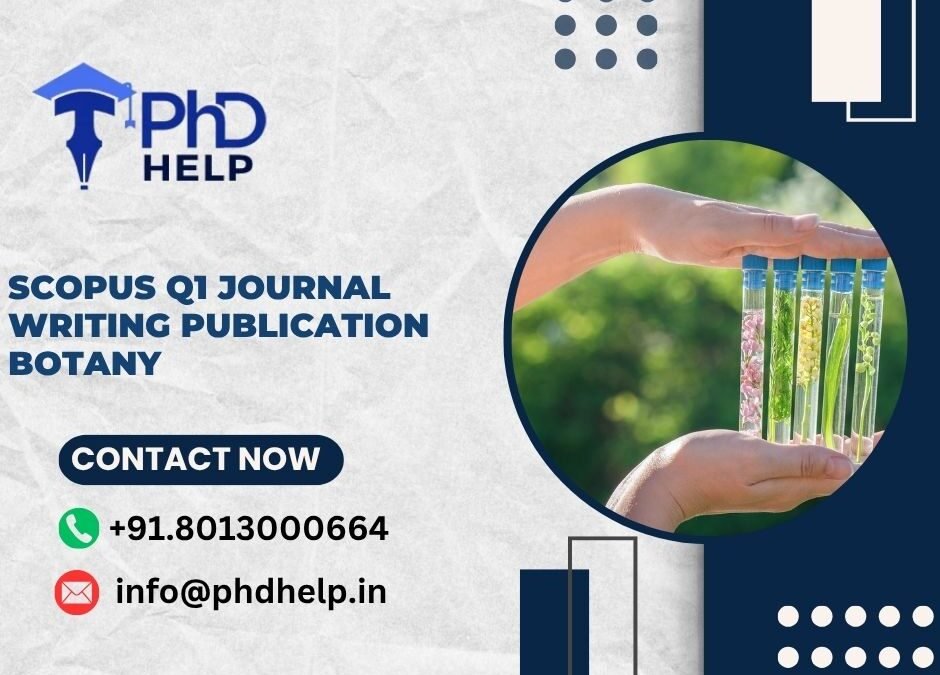SCOPUS Q1 journal writing publication Botany
SCOPUS Q1 journal writing publication Botany. Publishing in a SCOPUS Q1 journal in Botany is a hallmark of academic excellence, reflecting cutting-edge research in plant science. With the increasing global focus on biodiversity, climate change, and sustainable agriculture, high-impact botanical research requires meticulous writing, structured presentation, and strategic submission to top-tier journals. SCOPUS Q1 journals offer maximum visibility, international recognition, and citation potential, making them the ideal platform for researchers aiming to influence the field of botany.
Understanding SCOPUS Q1 Journals in Botany
SCOPUS Q1 journals represent the top 25% of journals within their subject area, defined by impact factor, citations, and academic reputation. For botanical research, these journals cover areas such as plant physiology, molecular biology, taxonomy, ecology, and environmental botany. Publishing in a Q1 journal not only enhances the author’s academic profile but also ensures that the research reaches leading scientists, policymakers, and institutions worldwide.
Manuscript Preparation: Structuring Botanical Research for Impact
Effective SCOPUS Q1 journal writing in Botany begins with meticulous manuscript preparation. Authors should focus on a clear and concise title, an informative abstract, and structured sections including Introduction, Materials and Methods, Results, Discussion, and Conclusion. Each section must emphasize scientific rigor, reproducibility, and relevance to current botanical challenges, such as climate resilience, conservation, or plant-based pharmaceuticals. Figures, tables, and illustrations should be high-quality, accurately labeled, and integrated seamlessly into the text.
Literature Review: Establishing Context and Significance
A critical component of SCOPUS Q1 journal articles is a comprehensive literature review. It demonstrates the author’s awareness of existing research, identifies knowledge gaps, and establishes the significance of the study. For botanical research, this may include studies on plant genomics, photosynthesis optimization, ecological modeling, or ethnobotany. Citations must follow journal-specific guidelines and prioritize recent, high-impact studies to enhance credibility.
Scientific Writing and Language Excellence
SCOPUS Q1 journals demand precise, formal, and technically accurate language. Scientific writing should be concise, objective, and free of ambiguity, avoiding redundancy while conveying complex botanical phenomena clearly. Authors are encouraged to use active voice for clarity, define technical terms, and maintain consistency in terminology. Professional editing services can enhance language quality, ensuring alignment with international academic standards.
Data Presentation and Statistical Analysis
High-impact botanical research relies on robust data presentation and statistical rigor. Results should be presented through well-organized tables, graphs, and images, highlighting significant findings without overwhelming readers. Statistical analyses must be described clearly, including software used, sample size, and significance levels. SCOPUS Q1 journals prioritize transparency and reproducibility, requiring authors to provide raw data or supplementary materials when applicable.
Peer Review Readiness: Ensuring Acceptance
Preparing for peer review is critical for SCOPUS Q1 journal publication. Manuscripts should anticipate reviewer expectations by addressing potential methodological concerns, ensuring ethical compliance, and highlighting the novelty of the research. Pre-submission review by colleagues or professional editors can identify weaknesses, correct errors, and improve the overall quality of the paper, increasing the chances of acceptance.
Journal Selection: Targeting the Right SCOPUS Q1 Platform
Choosing the right journal is crucial for maximizing impact. Factors to consider include the journal’s scope, readership, impact factor, and previous publications in related botanical fields. High-impact Q1 journals in Botany often focus on molecular biology, plant ecology, sustainable agriculture, or climate adaptation. Proper journal selection aligns the manuscript with the target audience and increases visibility and citation potential.
Submission and Follow-Up Management
Efficient submission management is essential for SCOPUS Q1 publication. This includes preparing the manuscript according to journal guidelines, formatting references correctly, submitting supplementary materials, and maintaining communication with editors. Timely responses to reviewer comments and careful revision improve acceptance rates. Professional support services help navigate these processes, reducing delays and optimizing the publication timeline.
Ethical Compliance in Botanical Research
SCOPUS Q1 journals uphold high ethical standards. Authors must ensure proper citation, avoid plagiarism, and follow guidelines for plant material collection, experimentation, and environmental compliance. Ethical transparency strengthens credibility, fosters trust, and ensures that research contributes responsibly to the global botanical knowledge base.
Post-Publication Visibility and Impact
After acceptance, promoting the published work enhances reach and citation potential. Indexing in SCOPUS, PubMed, and Web of Science ensures accessibility to researchers worldwide. Authors may also engage in conference presentations, social media promotion, and academic networking to increase visibility. High-impact dissemination ensures that botanical research informs future studies, policy decisions, and practical applications in agriculture, conservation, and pharmacology.
Conclusion: Excellence in Botanical Publishing
Publishing in SCOPUS Q1 journals in Botany is a gateway to international recognition, academic credibility, and meaningful scientific impact. From structured manuscript preparation and literature review to statistical rigor, ethical compliance, and submission management, each step is critical for success. By following best practices in high-quality journal writing, authors can ensure that their botanical research reaches a global audience, advances scientific knowledge, and contributes to the sustainable management and understanding of plant life.
SCOPUS Q1 journal writing publication in Botany is essential for researchers seeking to establish authority, enhance visibility, and make a lasting impact in plant sciences.
Thank you for read our blog “SCOPUS Q1 journal writing publication Botany”
Also read our more BLOG here
For PhD writing help Contact: +91.8013000664 || info@phdhelp.in

